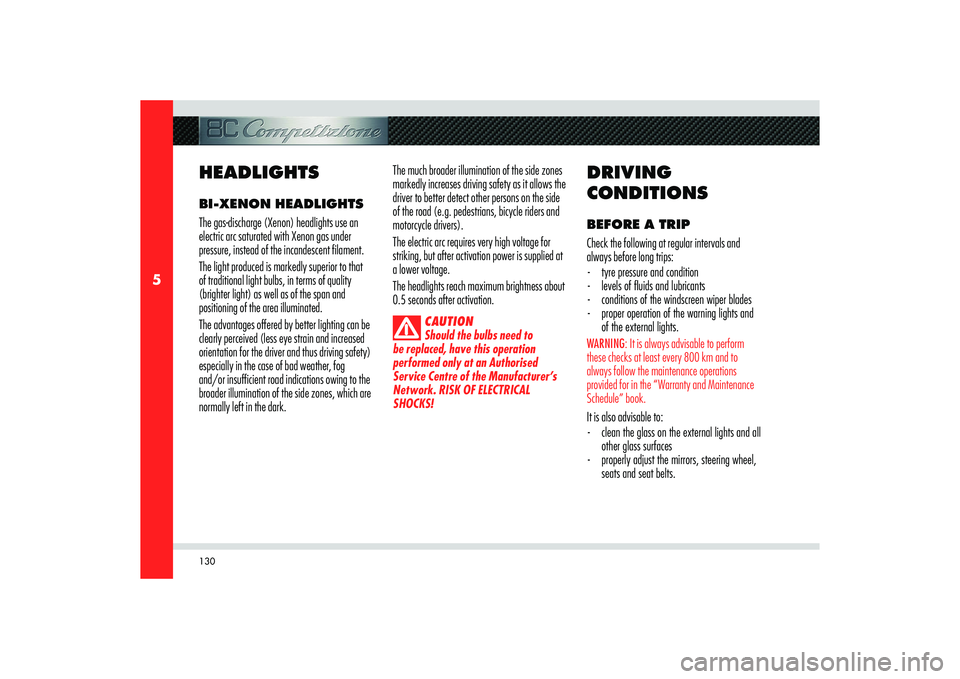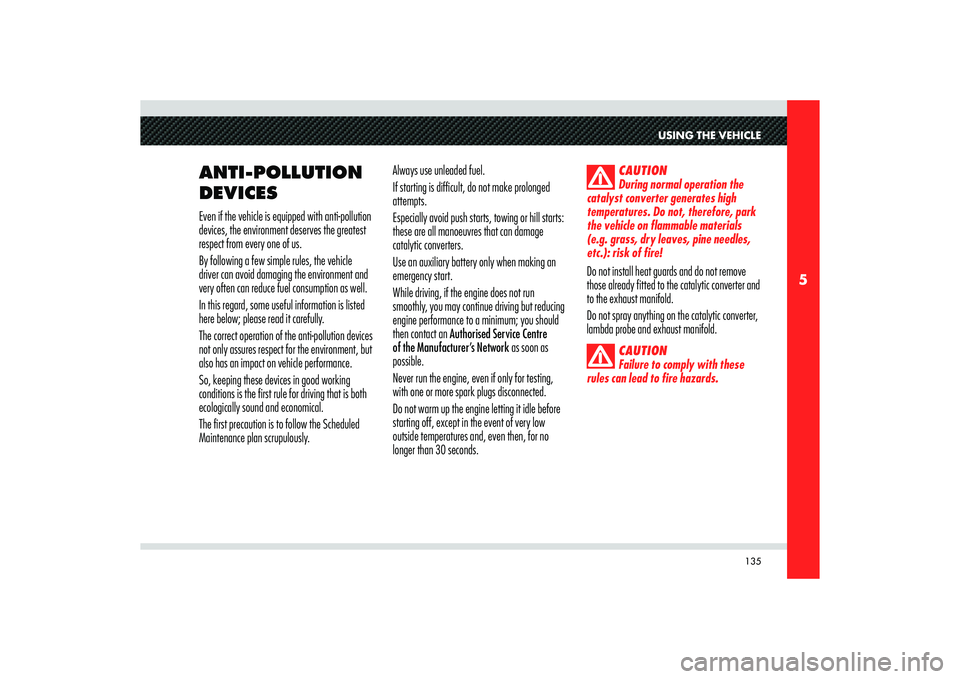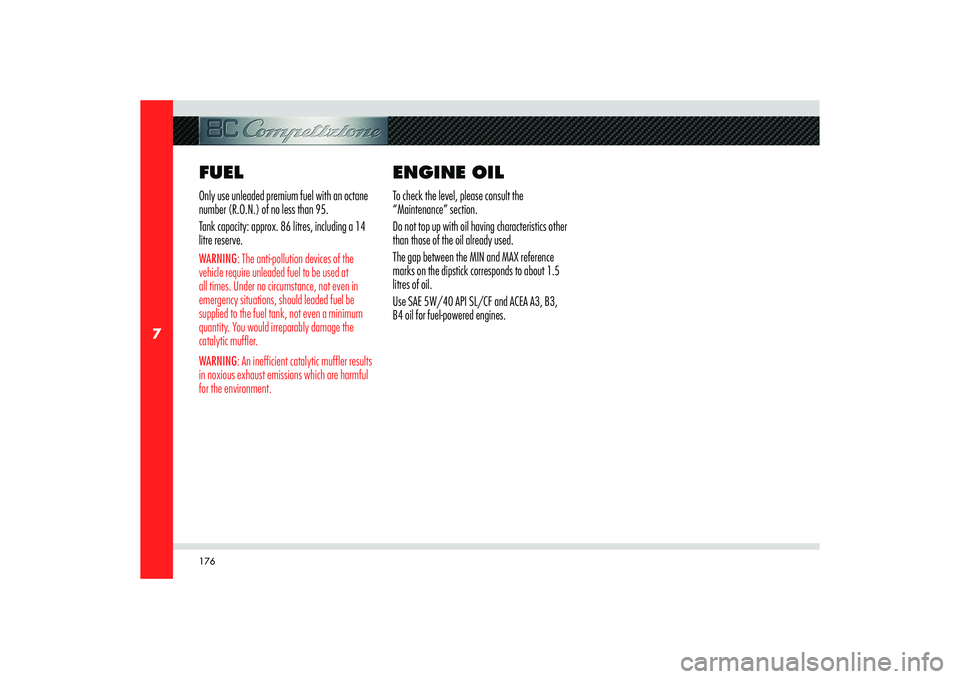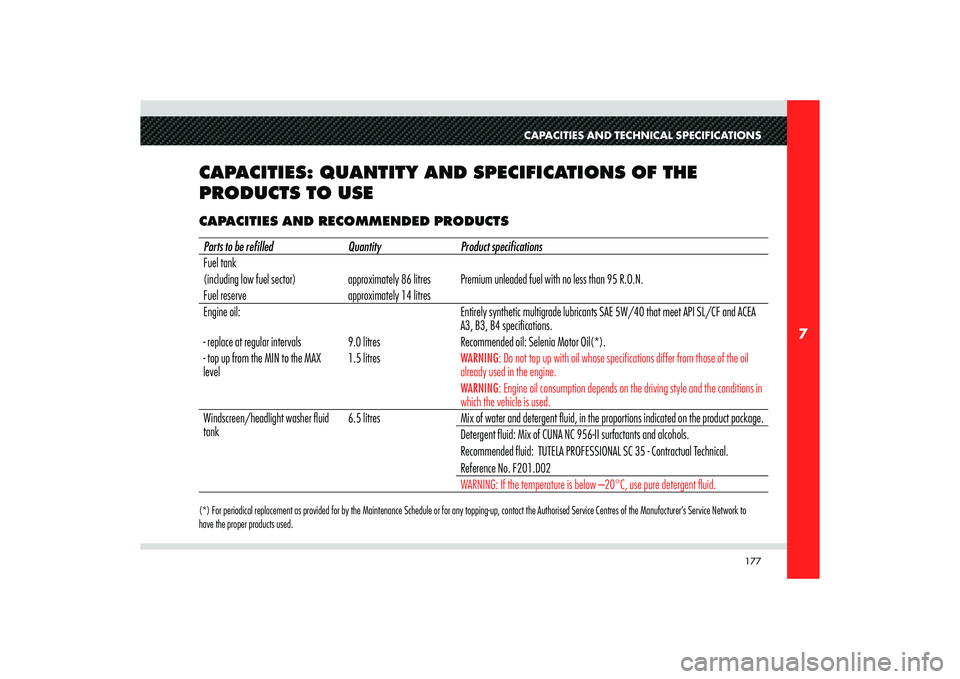maintenance Alfa Romeo 8C 2007 Owner handbook (in English)
[x] Cancel search | Manufacturer: ALFA ROMEO, Model Year: 2007, Model line: 8C, Model: Alfa Romeo 8C 2007Pages: 223, PDF Size: 14.35 MB
Page 114 of 223

5VEHICLE IDENTIFICATION DATA
ACTIVE AND PASSIVE SAFETY
INSTRUMENTS AND CONTROLS
BEFORE YOU DRIVE
USING THE VEHICLE
IN AN EMERGENCY
CAPACITIES AND TECHNICAL SPECIFICATIONS
MAINTENANCE
TABLE OF CONTENTS
Page 132 of 223

130
5
HEADLIGHTSBI-XENON HEADLIGHTS
The gas-discharge (Xenon) headlights use an
electric arc saturated with Xenon gas under
pressure, instead of the incandescent filament.
The light produced is markedly superior to that
of traditional light bulbs, in terms of quality
(brighter light) as well as of the span and
positioning of the area illuminated.
The advantages offered by better lighting can be
clearly perceived (less eye strain and increased
orientation for the driver and thus driving safety)
especially in the case of bad weather, fog
and/or insufficient road indications owing to the
broader illumination of the side zones, which are
normally left in the dark.The much broader illumination of the side zones
markedly increases driving safety as it allows the
driver to better detect other persons on the side
of the road (e.g. pedestrians, bicycle riders and
motorcycle drivers).
The electric arc requires very high voltage for
striking, but after activation power is supplied at
a lower voltage.
The headlights reach maximum brightness about
0.5 seconds after activation.
CAUTION
Should the bulbs need to
be replaced, have this operation
performed only at an Authorised
Service Centre of the Manufacturer’s
Network. RISK OF ELECTRICAL
SHOCKS!
DRIVING
CONDITIONSBEFORE A TRIP
Check the following at regular intervals and
always before long trips:
- tyre pressure and condition
- levels of fl uids and lubricants
- conditions of the windscreen wiper blades
- proper operation of the warning lights and
of the external lights.WARNING: It is always advisable to perform
these checks at least every 800 km and to
always follow the maintenance operations
provided for in the “Warranty and Maintenance
Schedule” book.It is also advisable to:
- clean the glass on the external lights and all
other glass surfaces
- properly adjust the mirrors, steering wheel,
seats and seat belts.
Page 137 of 223

135
5
USING THE VEHICLE
ANTI-POLLUTION
DEVICES Even if the vehicle is equipped with anti-pollution
devices, the environment deserves the greatest
respect from every one of us.
By following a few simple rules, the vehicle
driver can avoid damaging the environment and
very often can reduce fuel consumption as well.
In this regard, some useful information is listed
here below; please read it carefully.
The correct operation of the anti-pollution devices
not only assures respect for the environment, but
also has an impact on vehicle performance.
So, keeping these devices in good working
conditions is the first rule for driving that is both
ecologically sound and economical.
The first precaution is to follow the Scheduled
Maintenance plan scrupulously. Always use unleaded fuel.
If starting is difficult, do not make prolonged
attempts.
Especially avoid push starts, towing or hill starts:
these are all manoeuvres that can damage
catalytic converters.
Use an auxiliary battery only when making an
emergency start.
While driving, if the engine does not run
smoothly, you may continue driving but reducing
engine performance to a minimum; you should
then contact an Authorised Service Centre
of the Manufacturer’s Network as soon as
possible.
Never run the engine, even if only for testing,
with one or more spark plugs disconnected.
Do not warm up the engine letting it idle before
starting off, except in the event of very low
outside temperatures and, even then, for no
longer than 30 seconds.
CAUTION
During normal operation the
catalyst converter generates high
temperatures. Do not, therefore, park
the vehicle on flammable materials
(e.g. grass, dry leaves, pine needles,
etc.): risk of fire!
Do not install heat guards and do not remove
those already fitted to the catalytic converter and
to the exhaust manifold.
Do not spray anything on the catalytic converter,
lambda probe and exhaust manifold.
CAUTION
Failure to comply with these
rules can lead to fire hazards.
Page 142 of 223

140
5
D
- Parking brake system overhaul
The EPB system requires maintenance,
therefore contact an Authorised Service
Centre of the Manufacturer’s Network to
have the system corrected.
CAUTION
In the event of an electric
parking brake failure, contact an
Authorised Service Centre of the
Manufacturer’s Network as soon as
possible.
Emergency disengagement
In the event that the electric parking brake locks
with a total system failure, you need to manually
release the parking brake using the special tool
provided in the toolkit.
Proceed as follows:
- Move the left-hand seat fully forward and
fully tilt the backrest.
- Using a screwdriver remove the cover
D by
prising on its left-hand side.- Insert the special tool in the just uncovered
pipe.
- Turn the handle clockwise until it is
released.
- Remove the tool from the pipe and refi t the
cover.
CAUTION
After each manual emergency
release, the electric parking brake
system will be inefficient until its
operation is corrected by an Authorised
Service Centre of the Manufacturer’s
Network.
Page 146 of 223

6VEHICLE IDENTIFICATION DATA
ACTIVE AND PASSIVE SAFETY
INSTRUMENTS AND CONTROLS
BEFORE YOU DRIVE
USING THE VEHICLE
IN AN EMERGENCY
CAPACITIES AND TECHNICAL SPECIFICATIONS
MAINTENANCE
TABLE OF CONTENTS
Page 170 of 223

168
6
B
C
A
IF THE BATTERY IS
FLAT First of all, we recommend that you read
the precautions contained in the section
”Maintenance“ to prevent the battery from
running flat and to help ensure its long life.
STARTING WITH THE
AUXILIARY BATTERY
See the chapter ”Starting the engine“ on page
114 in the section ”Using the vehicle”.WARNING: Under no circumstance should a
battery be used for an emergency start-up: This
could damage the electronic systems, particularly
the control units managing the ignition and fuel
supply functions.
RECHARGING THE
BATTERY
You are advised to recharge the battery slowly
and at a low amperage for about 24 hours.
Proceed as follows:
1) Deactivate the electronic alarm using the
radio control.
2) Lift the rear shelf
A and the box cover
B
and release the hooks
C.
WARNING: First disconnect the negative pole
terminal (–) then the positive pole one (+).3) Connect the battery charger cables to the
battery poles.WARNING: The battery is housed in a metal box, therefore, be extremely careful not to let the
battery charger clips come into contact with it.
4) Turn on the battery charger.
5) When the battery is recharged, turn off the
battery charger before disconnecting it from
the battery.
6) Reconnect the terminals to the battery
poles, observing the polarity.WARNING: First reconnect the positive pole
terminal (+) and then the negative pole one
(–).
WARNING: Before reconnecting the battery
terminals, check that the key has been removed
from the ignition or at least that it is in the STOP
position.
Page 176 of 223

7VEHICLE IDENTIFICATION DATA
ACTIVE AND PASSIVE SAFETY
INSTRUMENTS AND CONTROLS
BEFORE YOU DRIVE
USING THE VEHICLE
IN AN EMERGENCY
CAPACITIES AND TECHNICAL SPECIFICATIONS
MAINTENANCE
TABLE OF CONTENTS
Page 178 of 223

176
7
FUELOnly use unleaded premium fuel with an octane
number (R.O.N.) of no less than 95.
Tank capacity: approx. 86 litres, including a 14
litre reserve.WARNING: The anti-pollution devices of the
vehicle require unleaded fuel to be used at
all times. Under no circumstance, not even in
emergency situations, should leaded fuel be
supplied to the fuel tank, not even a minimum
quantity. You would irreparably damage the
catalytic muffler.
WARNING: An inefficient catalytic muffler results
in noxious exhaust emissions which are harmful
for the environment.
ENGINE OILTo check the level, please consult the
“Maintenance” section.
Do not top up with oil having characteristics other
than those of the oil already used.
The gap between the MIN and MAX reference
marks on the dipstick corresponds to about 1.5
litres of oil.
Use SAE 5W/40 API SL/CF and ACEA A3, B3,
B4 oil for fuel-powered engines.
Page 179 of 223

177
7
CAPACITIES AND TECHNICAL SPECIFICATIONS
CAPACITIES: QUANTITY AND SPECIFICATIONS OF THE
PRODUCTS TO USECAPACITIES AND RECOMMENDED PRODUCTS(*) For periodical replacement as provided for by the Maintenance Schedule or for any topping-up, contact the Authorised Service Centres of the Manufacturer’s Service Network to
have the proper products used. Parts to be refi lled Quantity Product specifi cations
Fuel tank
(including low fuel sector) approximately 86 litres Premium unleaded fuel with no less than 95 R.O.N.
Fuel reserve approximately 14 litres
Engine oil: Entirely synthetic multigrade lubricants SAE 5W/40 that meet API SL/CF and ACEA
A3, B3, B4 specifications.
- replace at regular intervals 9.0 litres Recommended oil: Selenia Motor Oil(*).
- top up from the MIN to the MAX
level1.5 litres
WARNING: Do not top up with oil whose specifications differ from those of the oil
already used in the engine.
WARNING: Engine oil consumption depends on the driving style and the conditions in
which the vehicle is used.
Windscreen/headlight washer fluid
tank6.5 litres Mix of water and detergent fluid, in the proportions indicated on the product package.
Detergent fluid: Mix of CUNA NC 956-II surfactants and alcohols.
Recommended fluid: TUTELA PROFESSIONAL SC 35 - Contractual Technical.
Reference No. F201.D02
WARNING: If the temperature is below –20°C, use pure detergent fluid.
Page 190 of 223

8VEHICLE IDENTIFICATION DATA
ACTIVE AND PASSIVE SAFETY
INSTRUMENTS AND CONTROLS
BEFORE YOU DRIVE
USING THE VEHICLE
IN AN EMERGENCY
CAPACITIES AND TECHNICAL SPECIFICATIONS
MAINTENANCE
TABLE OF CONTENTS